2018 Statistical Monitoring Report on the Implementation of China National Program for Women’s Development (2011–2020)
National Bureau of Statistics of China
December 2019
In order to assess the implementation of the China National Program for Women’s Development (2011–2020), hereinafter referred to as the NPA for Women, the National Bureau of Statistics conducted a comprehensive analysis in seven areas, including health, education, economy, decision-making and management, social security, environment and law in 2018 based on statistics and data provided by the relevant sectoral departments. The results indicated that the overall implementation is progressing smoothly, and most targets have been achieved in advance of the 2020 timeline. However, the targets in a few areas require further attention.
I. Implementation Progress of the NPA for Women in Seven Areas
1) Women and Health
The overall maternal health has been improved. In 2018, various indicators on maternal health continued to improve, particularly the hospital delivery rate of pregnant women has remained at above 99% since 2012. In 2018, the hospital delivery rate was 99.9%, unchanged from the previous year and 2.1 percentage points higher than 2010. The maternal systematic management rate was 89.9%, a slight increase of 0.3 percentage points from the previous year and an increase of 5.8 percentage points from 2010. Compared with 2010, the antenatal care coverage and postnatal care coverage have been improved to varying degrees.
The maternal mortality ratio continues to decrease. In 2018, the maternal mortality ratio was 18.3 per 100,000 live births, a decrease of 6.6% over the previous year and a decrease of 39% over 2010, which is better than the average level of upper-middle income countries. In the same period, the urban and rural maternal mortality ratios were 15.5/100,000 and 19.9/100,000, respectively, 6.6% and 5.7% lower than the previous year, and 47.8% and 33.9% lower than in 2010 (see Figure 1).
Figure 1 Maternal Mortality Ratio, 2010–2018
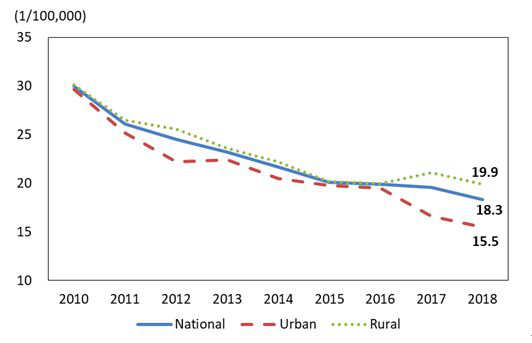
Women's reproductive health services have been strengthened continuously. The Government has provided free essential technical services for family planning and promoted knowledge on contraception and birth control, quality childbearing and reproductive health to improve reproductive health of its citizens. The national contraceptive prevalence rate among married women of reproductive age has remained above 80%. As of the end of 2018, cervical and breast cancer checkup for women in rural areas has covered all poverty counties across the country. After several years of low screening rates, the screening rate for common gynecological diseases has increased significantly, from 61.2% in 2010 to 75.5% in 2018, an increase of 14.3 percentage points, and 8.6 percentage points higher than 2017. However, this is still below the target of above 80% set out in the NPA for Women (see Figure 2).
Figure 2 Screening Rate for Common Gynecological Diseases, 2010-2018
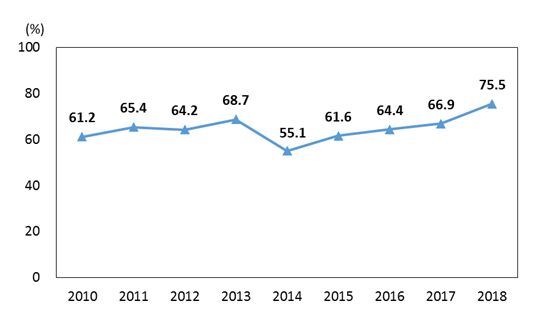
2) Women and Education
The proportion of girls receiving pre-primary education has steadily increased. In 2018, there were 46.56 million children attending pre-primary education (including kindergartens and pre-primary classes attached to schools), of which 21.77 million were girls. This was an increase of 563 thousand children and 276 thousand girls over the previous year, and an increase of 16.80 million children and 8.24 million girls from 2010. The proportion of girls in pre-primary education was 46.7%, an increase of 1.3 percentage points from 2010. The gross enrollment ratio of pre-primary education also rose rapidly, from 56.6% in 2010 to 81.7% in 2018, an increase of 25.1 percentage points.
The gender gap in compulsory education has been basically eliminated. In 2018, the survival rate of the nine-year compulsory education was 94.2%, an increase of 3.1 percentage points from 2010. The net enrollment rate of primary school-age children was close to 100%, and there was no significant gender gap between girls and boys. In 2018, the proportion of female students in school during the nine-year compulsory education stage was 46.5%. In recent years, this indicator has been stable between 46.4% and 46.6%.
The proportion of girls continues to increase at the senior secondary education stage [1]. In 2018, there were 18.65 million girls in senior secondary education, accounting for 47.4% of all students in school, an increase of 0.3 percentage points from 2010. The gross enrollment ratio of senior secondary education increased from 82.5% in 2010 to 88.8% in 2018, an increase of 6.3 percentage points. In particular, the proportion of female students in regular senior secondary education has been more than half since 2015. It was 50.8% in 2018, an increase of 2.2 percentage points from 2010 (see Figure 3).
Figure 3 Proportion of Girls in Regular Senior Secondary Education, 2010–2018
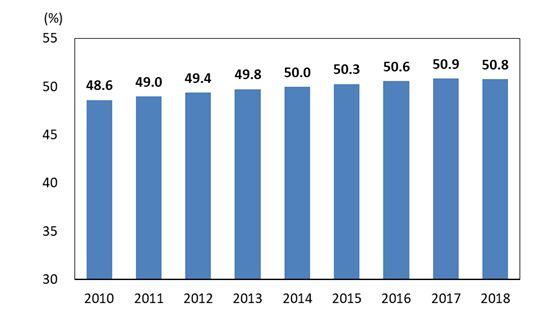
Women's access to higher education has been improved. In recent years, higher education in China has developed rapidly, and achieved above average level globally. The gross enrollment ratio of higher education increased rapidly from 26.5% in 2010 to 48.1% in 2018, and since 2015, the NPA target of 40% has been achieved ahead of the 2020 timeline. In 2018, the number of female graduate students in higher education was 1.36 million, accounting for 49.6% of all graduate students, and an increase of 1.8 percentage points compared with 2010. There were 14.87 million female students in colleges and universities, accounting for 52.5%, and an increase of 1.6 percentage points from 2010 (See Figure 4). There were 3.51 million female students in adult programs of colleges and universities, accounting for 59.4%, an increase of 6.2 percentage points from 2010.
Figure 4 Number and Proportion of Female Students in College and University Education, 2010-2018
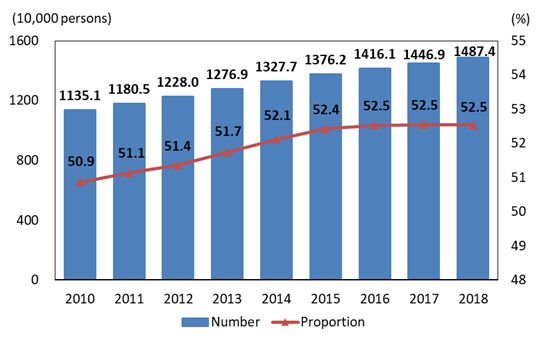
3) Women and the Economy
Women account for over 40% of the employed population. Women's employment choices are more diversified, and the notion that women hold up half the sky has become more prominent. In 2018, the proportion of women employed in the country as a percentage of the total employed population was 43.7%, an increase of 0.2 percentage points over the previous year, exceeding the NPA target of “maintaining above 40%”.
The number of rural poor women has decreased significantly. Calculated based on the rural poverty standard of an annual per capita income of RMB 2,300 (constant price of 2010), the rural poor population in the country totaled 16.60 million in 2018. This was a decrease of nearly 150 million from 2010, of which about half were women. In 2018, the rural poverty rate was 1.7%, 15.5 percentage points lower than in 2010.
Government’s efforts to support poor women have been increasing. The Government has continuously improved the new social assistance system to provide increased social protection for poor women, with the average standard of the minimum subsistence allowance (Dibao) in urban and rural areas increasing year by year. In 2018, the average standard of Dibao in urban and rural areas was about RMB 490 per month, an increase of RMB 40 over the previous year, and an increase of RMB 304 from 2010. The urban and rural residents who received Dibao and the rural people living in extreme difficulty that received social assistance totaled 49.81 million, of which 19.85 million were women, accounting for nearly 40%.
4) Women’s Participation in Decision-Making and Management
The proportions of female delegates of the National People’s Congress (NPC) and female members of the Chinese People’s Political Consultative Conference (CPPCC) were the highest in history. The 13th session of the NPC has 742 female delegates, accounting for 24.9% of the total, and an increase of 1.5 percentage points from the previous session. This is the session with the highest proportion of female delegates in history. The 13th session of the National Committee of the CPPCC has 440 female members, accounting for 20.4% of the total, and 2.6 percentage points higher than the previous session. It is also the session with the highest proportion of female CPPCC members (see Figure 5).
Figure 5 Proportion of Female NPC Delegates and Female CPPCC Members
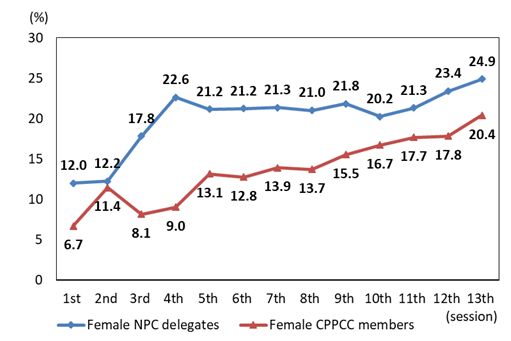
Women have actively participated in business management. In 2018, the percentage of female directors on the boards of directors of enterprises accounted for 39.9%, and the percentage of female supervisors on the boards of supervisors of enterprises accounted for 41.9%. This was 0.2 and 0.3 percentage points higher than the previous year, and an increase of 7.2 and 6.7 percentage points from 2010, respectively (see Figure 6).
Figure 6 Proportion of Females on Boards of Directors and Boards of Supervisors of Enterprises, 2010–2018
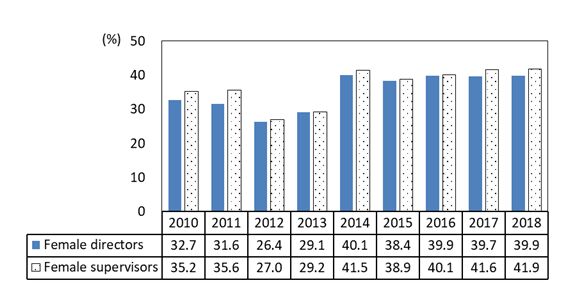
Women have also actively participated in democratic governance at the grassroots level. In recent years, women in China have widely participated in democratic governance at the grassroots level, especially within resident committees. In 2018, the proportion of women in resident committees was 50.4%, an increase of 0.7 percentage points from the previous year, and already achieved the NPA target. In 2018, the proportion of female members in villagers’ committees was 11.1%, an increase of 0.4 percentage points from the previous year.
5) Women and Social Security
Maternity insurance for women has been improved. Maternity insurance coverage affects the vital interests of many female employees, and the number of women participating in maternity insurance in recent years has increased rapidly. In 2018, the number of women participating in maternity insurance reached 89.27 million, an increase of 4.99 million or 5.9% over the previous year, and an increase of 35.60 million or 66.3% from 2010 (see Figure 7). The proportion of women insured among the total insured population was 43.7%. This figure was the same as the previous year, and 0.2 percentage points higher than 2010.
Figure 7 Number of Women Participating in Maternity Insurance, 2010–2018
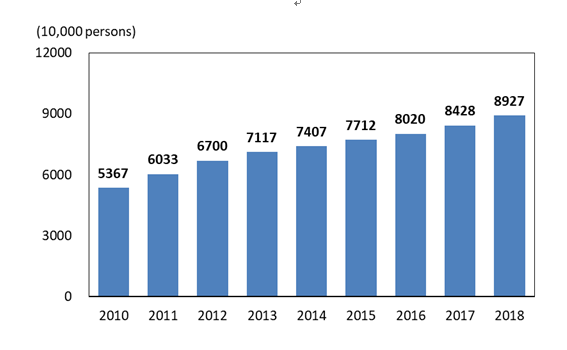
Basic medical insurance coverage for women has continued to expand. According to incomplete statistics, the total number of women who participated in basic medical insurance exceeded 540 million in 2018, an increase of 19.26 million from the previous year, and 2.9 times that of 2011. Specifically, the number of women who participated in basic medical insurance for urban employees was 150 million, an increase of 6.43 million over the previous year, and an increase of 35.47 million from 2011. The number of women who participated in the basic medical insurance for urban and rural residents exceeded 390 million[2], an increase of 12.83 million, and 5.2 times that of 2011.
More women benefited from the basic pension insurance. According to incomplete statistics, 430 million women participated in basic pension insurance in 2018, an increase of 44.20 million over the previous year, and an increase of 82.14 million from 2016 [3]. Specifically, the number of women who participated in the basic pension insurance for urban employees was 190 million [4] an increase of 9.58 million over the previous year, and an increase of 74.65 million or 66.6% from 2010. The number of women who participated in the basic pension insurance for urban and rural residents was 240 million [5], an increase of 34.63 million over the previous year, and an increase of 72.10 million or 42.3% from 2016.
The number of women participating in unemployment insurance and work-related injury insurance has increased. In recent years, the number of women participating in unemployment insurance and work-related injury insurance has been continuously increasing. In 2018, the number of women who participated in unemployment insurance was 83.41 million, an increase of 3.92 million over the previous year, and an increase of 31.92 million or 62% from 2010. The number of women who participated in work-related injury insurance was 93.13 million, an increase of 7.19 million over the previous year, and an increase of 36.14 million or 63.4% from 2010.
6) Women and the Environment
The ecological environment has been further improved. In 2018, a total of 474 national-level nature reserves were established, an increase of 11 nature reserves over the previous year, and an increase of 155 nature reserves from 2010. According to the data from the Ninth National Forest Resources Inventory (2014–2018), the country's forest area exceeded 220 million hectares, an increase of 12.76 million hectares compared with the eighth inventory findings. The forest coverage rate was 23%, an increase of 1.3 percentage points from the eighth inventory findings.
The urban environment has been improved continuously. In 2018, the per capita park and green space was 14.1 square meters nationwide, an increase of 2.9 square meters from 2010. The greenery coverage of urban built-up areas was 41.1%, an increase of 2.5 percentage points from 2010. The urban sewage treatment rate was 95.5%, an increase of 13.2 percentage points from 2010. The rate of harmless disposal of household solid waste in urban areas increased from 77.9% in 2010 to 99% in 2018, an increase of 21 percentage points, and 1.3 percentage points higher than the previous year.
The efforts to improve rural environment have been strengthened. The Rural Revitalization Strategic Plan (2018–2022) issued by the Central Committee of the Communist Party of China and the State Council provided institutional guarantees for improving the rural environment and optimizing the living environment of rural residents, as well as steadily advancing the construction of a beautiful countryside. In 2018, the proportion of rural residents benefiting from centralized water supply reached 86%, an increase of 28 percentage points from 2010, and a further step after achieving the NPA target of around 85% in 2017 (see Figure 8).
Figure 8 Proportion of Rural Residents Benefiting from Centralized Water Supply, 2010–2018
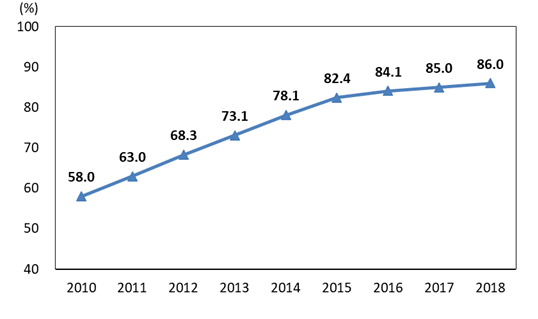
7) Women and the Law
The legal system for protecting women's rights and interests has been continuously improved. For a long time, China has continuously strengthened the rule of law for gender equality. At present, there is an established legal system to protect women's rights and promote gender equality. This legal system is based on the Constitution, with the Law on the Protection of Women's Rights and Interests at its core, and supplemented by various national laws and local regulations.
A gender equality review mechanism has been established for government regulations and policies. As of the end of 2018, a total of 30 provinces, autonomous regions and municipalities across the country have established a gender equality review mechanism for laws and regulations, which have embedded the concept of gender equality into the formulation, implementation and supervision of laws and policies, and created a new system to protect women's rights and promote equal development of women and men.
The legal aid support to women has also been expanded. Relevant departments have vigorously promoted the establishment of public legal service entities, hotlines, and online platforms, continuously expanding the scope of the protection of women's rights and interests, and gradually improving the legal aid and judicial assistance systems. In 2018, there were 3,389 government legal aid institutions at the provincial, prefecture and county levels, with legal aid services provided more than 360 thousand person times to women.
China has diligently cracked down on the crime of trafficking of women and children. In order to ruthlessly crack down on the crime of trafficking of women and children, China released its second anti-trafficking action plan, titled National Plan of Action on Combating Human Trafficking (2013–2020). Relevant departments have carried out various actions to increase the rectification of the "buyer's market" for human trafficking, and reduce the occurrence of human trafficking cases at its source. In 2018, public security organs in China solved 434 cases related to the trafficking of women.
II Key Challenges Encountered during Implementation of the NPA for Women
The year 2020 will be the last year of implementation for the current NPA for Women. As of the end of 2018, most of the NPA targets have been achieved. However, gaps still exist in the screening rate of common gynecological diseases, the proportion of female members in villagers’ committees, and the access to sanitary toilets in rural areas. Moreover, significant efforts are required to gradually reduce the gap between urban and rural areas in terms of maternal mortality ratio, and to increase the proportion of females in vocational education.
1) Regional development gaps in women's health still exist.
Although maternal and child health has been improved greatly in China, there is still uneven development among regions. In 2018, the maternal mortality ratio in the eastern region was 10.9 per 100,000 live births, and the ratio in western region was 25.2 per 100,000, with the figure in the western region 2.3 times that of the eastern region.
2) The level of rural women’s political participation needs to be further improved.
In 2018, the proportion of female members in villagers’ committees was 24%. Although this was 0.9 percentage points higher than the previous year and 2.6 percentage points higher than 2010, it is still far from the NPA target of “over 30%” (See Figure 9).
Figure 9 Proportion of Female Members in Villagers’ Committees, 2010–2018
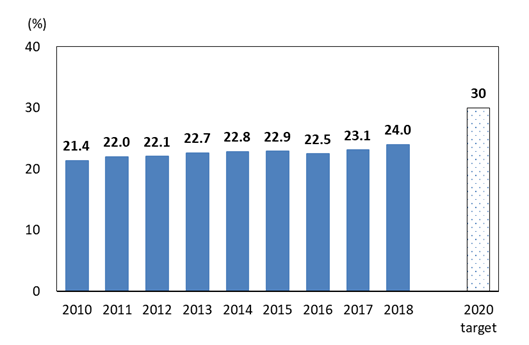
Notes:
[1] The senior secondary education stage includes regular senior secondary school, senior secondary school for adults, regular and adult specialized secondary education, senior secondary vocational school, and vocational-technical school.
[2] The number of women who participated in basic medical insurance for urban and rural residents does not include the New Rural Cooperative Medical Insurance data from seven provinces, including Liaoning, Jilin, Anhui, Hainan, Guizhou, Tibet and Shaanxi.
[3] Since 2016, the data on the basic pension insurance for urban and rural residents was disaggregated by sex.
[4] The number of women who participated in the basic pension insurance for urban employees does not include those working for the central government
[5] The number of women who participated in the basic pension insurance for urban and rural residents does not include urban data from Guizhou and Tibet and rural data from Tibet.
*In case of any difference between English translation and the original Chinese text, the Chinese edition shall prevail.
